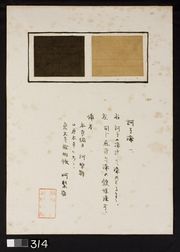Difference between revisions of "Myrobalan extract"
m (Text replace - "\[http:\/\/cameo\.mfa\.org\/materials\/fullrecord\.asp\?name=([^\s]+)\s(.*)\]" to "$2") |
|||
| (2 intermediate revisions by the same user not shown) | |||
| Line 1: | Line 1: | ||
| + | [[File:Uemura 09-10-2009 314.jpg|thumb|Silk dyed with Myrobalan<br>Uemera Dye Archive]] | ||
== Description == | == Description == | ||
A widely used vegetable tannin. Myrobalan extract is obtained from the dried, unripe fruit of several trees, such as Indian almond (''Terminalia catappa''), cherry plum (''Prunus cerasifera''), ''Phylanthus emblica'' and ''Terminalia chebala''. The dried fruit contain 30-32% tannins of the pyrogallol class. Myrobalan tannins have a natural acidity of pH 3.2 due to their relatively high sugar content (3 to 5% sugars) which ferment in the tanning liquor. When used alone, myrobalan tannins tend to form a heavy porous leather, so it is usually mixed with other more astringent tannins, such as [[wattle%20bark|wattle]], [[quebracho|quebracho]] or [[mangrove|mangrove]]. Myrobalan extract is also used as a black dye on wool and as an ink colorant. Its primary dye component is [[ellagic%20acid|ellagic acid]]. | A widely used vegetable tannin. Myrobalan extract is obtained from the dried, unripe fruit of several trees, such as Indian almond (''Terminalia catappa''), cherry plum (''Prunus cerasifera''), ''Phylanthus emblica'' and ''Terminalia chebala''. The dried fruit contain 30-32% tannins of the pyrogallol class. Myrobalan tannins have a natural acidity of pH 3.2 due to their relatively high sugar content (3 to 5% sugars) which ferment in the tanning liquor. When used alone, myrobalan tannins tend to form a heavy porous leather, so it is usually mixed with other more astringent tannins, such as [[wattle%20bark|wattle]], [[quebracho|quebracho]] or [[mangrove|mangrove]]. Myrobalan extract is also used as a black dye on wool and as an ink colorant. Its primary dye component is [[ellagic%20acid|ellagic acid]]. | ||
| + | |||
| + | * See also [[https://cameo.mfa.org/wiki/Category:Uemura_dye_archive '''Uemera Dye Archive''' (Kashi)]] | ||
== Synonyms and Related Terms == | == Synonyms and Related Terms == | ||
| Line 7: | Line 10: | ||
myrobalans; myrabalans; Natural Brown 4; Natural Brown 6; valonia | myrobalans; myrabalans; Natural Brown 4; Natural Brown 6; valonia | ||
| − | == | + | == Resources and Citations == |
* Helmut Schweppe, Schweppe color collection index and information book Comment: Natural Brown 6 | * Helmut Schweppe, Schweppe color collection index and information book Comment: Natural Brown 6 | ||
Latest revision as of 13:00, 22 June 2022
Description
A widely used vegetable tannin. Myrobalan extract is obtained from the dried, unripe fruit of several trees, such as Indian almond (Terminalia catappa), cherry plum (Prunus cerasifera), Phylanthus emblica and Terminalia chebala. The dried fruit contain 30-32% tannins of the pyrogallol class. Myrobalan tannins have a natural acidity of pH 3.2 due to their relatively high sugar content (3 to 5% sugars) which ferment in the tanning liquor. When used alone, myrobalan tannins tend to form a heavy porous leather, so it is usually mixed with other more astringent tannins, such as wattle, Quebracho or Mangrove. Myrobalan extract is also used as a black dye on wool and as an ink colorant. Its primary dye component is Ellagic acid.
- See also [Uemera Dye Archive (Kashi)]
Synonyms and Related Terms
myrobalans; myrabalans; Natural Brown 4; Natural Brown 6; valonia
Resources and Citations
- Helmut Schweppe, Schweppe color collection index and information book Comment: Natural Brown 6
- G.S.Brady, Materials Handbook, McGraw-Hill Book Co., New York, 1971 Comment: p. 525
- Matt Roberts, Don Etherington, Bookbinding and the Conservation of Books: a Dictionary of Descriptive Terminology, U.S. Government Printing Office, Washington DC, 1982
- The American Heritage Dictionary or Encarta, via Microsoft Bookshelf 98, Microsoft Corp., 1998
- F. Crace-Calvert, Dyeing and Calico Printing, Palmer & Howe, London, 1876
- Colour Index International online at www.colour-index.org
